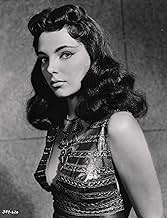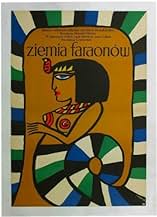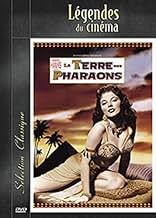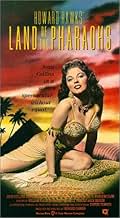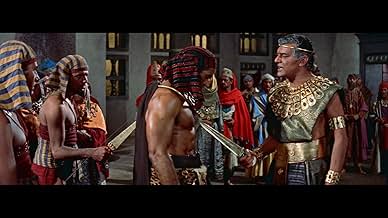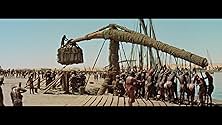Ein gefangener Architekt entwirft einen genialen Plan, um die Uneinnehmbarkeit des Grabes eines egozentrischen Pharaos zu gewährleisten, der von der Sicherheit seines nächsten Lebens besesse... Alles lesenEin gefangener Architekt entwirft einen genialen Plan, um die Uneinnehmbarkeit des Grabes eines egozentrischen Pharaos zu gewährleisten, der von der Sicherheit seines nächsten Lebens besessen ist.Ein gefangener Architekt entwirft einen genialen Plan, um die Uneinnehmbarkeit des Grabes eines egozentrischen Pharaos zu gewährleisten, der von der Sicherheit seines nächsten Lebens besessen ist.
- Regie
- Drehbuch
- Hauptbesetzung
- Kyra
- (as Luisa Boni)
- Egyptian Architect
- (Nicht genannt)
- Captain of the Guard
- (Nicht genannt)
- Dancer at the Party
- (Nicht genannt)
- Priest
- (Nicht genannt)
- Nabuna, Nellifer's Bodyguard
- (Nicht genannt)
- Bit Part
- (Nicht genannt)
- Mea
- (Nicht genannt)
- Dancer at the Party
- (Nicht genannt)
Empfohlene Bewertungen
Hawks's movie has one of the best ,most impressive and terrifying ending I know.These last pictures are a riveting tour de force with an editing to rival the best of Lang or Welles.The story spreads over fifteen years ,which is long for a relatively short work.Hawks was obviously more interested in his villains (Hawkins and Collins) than the heroes(the architect slave (Justice),his son and his people:both are fascinating.The pharaoh's dream of eternity is selfishness itself disguised as religion.To be buried with his riches to be able to enjoy them in his second life paradoxically seems a pagan attitude;the architect ,in direct contrast to him,is a slave who 's got nothing and he did not believe in life after life:it might make think of a Jew but neither him nor his people seem to have a religion,which is a very original move for a peplum (in Curtiz's "the Egyptian" ,the precedent year,the same went for the hero Sinouhe:these are the only examples in an epic).Hawks might have been influenced by Lang's wife's screenplay "das Indische Grabmal" ,which Lang finally took to the screen in the late fifties but which was filmed by others before him.Do not let the Faulkner reference fool you.He reportedly wrote half a page of script which can be summed up as follows:"Pharaoh pays a visit to the pyramid while the workers are sweating blood to get it done and he asks "how 's the work coming on?".
Nellifer is Joan Collins at her bitchiest: a greedy woman,who had already problems with dynasties.Unlike pharaoh,she wants to have her cake and eat it.Her acting is pure camp ,which fits the character like a glove.Her fate will make your hair stand on end.
Hawks makes a wonderful use of the cinemascope , when he displays a cast of thousands and when he directs his characters in the confined atmosphere of the pyramid.He succeeds in creating a sublime contrast between the dark subterranean of the grave and the luminous blue sky of the desert,particularly in the last sequences ,I say it again,among the very best of the fifties cinema.
As a grand epic from the era where they made them big and were not afraid to spend money where it would show up on screen, "Land of the Pharaohs" surpasses many other epics of its period and even many recent films dealing with a similar subject (1999's "The Mummy" comes to mind). "Pharaohs" has an impressive and very satisfying climax that makes perfect sense historically and dramatically.
Also, no one seems to have mentioned the marvelous handling of crowds, particularly in the lengthy building of the pyramid sequence. I'll even go so far as to say the way Hawks composes his crowds for the cinemascope screen - arranging his Egyptian workers and pharaoh worshipers in intricate patterns with complex movements - rivals even Fritz Lang's similar work in "Metropolis" (1926), famous for its handling of crowds.
I think one of the reasons the film keeps getting bashed is because people haven't seen it in its original widescreen format in many years. Until recently, no Region 1 DVD has been available, so in its cropped, pan and scan VHS incarnation, the film comes across as wimpy and ridiculous. As can be seen in the widescreen DVD release, the grandeur is stunning, its art direction, costumes, sets and locations all holding up marvelously.
It must be said that composer Dimitri Tiomkin probably never wrote a score as majestically spirited as this one, a vast canvas of antiquity and drama. The cast is very much of its time, and some of the dialog is stilted and dated, but with the passing of time, most films suffer from this. Time passes and acting styles change. But a good plot holds up, and "Pharaohs" has plenty of the devious vs altruistic characters that drove many of Hawks plots effectively.
The powers that be in Hollywood finally released the film on DVD, promoting it as a camp classic, adorning the cover with a cheesy shot of Joan Collins, the one thing they apparently consider notable and sell-able about the film. Too bad. Yes, "Land of the Pharaohs" does have an element of campiness, but there is true grandeur in the vastness of the production and the fact that its cast of thousands was indeed a cast of thousands, not CGI. Perhaps one day the wonders of this film will be given the appreciation it deserves. As time passes these epics seem to be acquiring as much antiquity as the genuine historical period itself.
Most of the acting is high-quality, especially the legendary Jack Hawkins who is magnificent as usual although Yul Brynner or Charleton Heston probably would have fit the role better.
Beautifully filmed with a very expensive look it is a movie with an obviously lavish budget. Despite the extravagance, I can fully understand why it didn't do well at the box-office. Focused on death and monuments it can be seen as somewhat depressing and has a grim, doomed aspect overall amid the splendor.
Unless maybe written by Edgar Allan Poe, how is a film about a tomb going to attract a great public to the theater? The answer is: it didn't. It is not an adventure about getting to a tomb such as Indiana Jones-type films, it is basically only a film about a tomb itself.
Death, murder, slavery, a tomb. If not handled just right these subjects can't succeed alone. Here they do, but just barely.
Over the years, many have criticized the film, including Howard Hawks, Hawkins and Collins. On close examination, their criticism of the dialogue is only partially justified. While there is some verbosity, and the discourse between Khufu and his first wife over his desire for a son seems unnecessary if not ridiculous(in this instance actions would speak louder than words)the dialogue is more than serviceable. During the funeral ritual for the heroic dead, the grand, evocative speech is even inspired.
Hawks also lamented that the film contained "no one to root for." Indeed, Hawkins' Pharaoh is decisive, infrequently warm and unquenchably greedy. As Princess Nellifer, Joan Collins is even more unsavory. There exists however, a necessary counterpoint in the character of Vashtar, who designs the pyramid in order to free his people. James Robertson Justice gives a sympathetic performance as the designer who is alternately good natured, thoughtful, and indignant at the pharaoh's cruelty. As the pharaohs advisor, Alexis Minotis manages a remarkable acting feat by enforcing Khufu's will and simultaneously evoking audience sympathy. As Vashtar's son, Dewey Martin's All-American boy persona is the only off key note.
Despite the generally capable acting, the film's chief attraction is the abundant spectacle. The thousands of workers toiling to build the pyramid, and the colorful court pageantry, are what linger most in the viewer's mind. The much-discussed ending may or may not be historically accurate, but is nevertheless filmed with a chilling sense of realism. In short, Land of the Pharaohs is an interesting thematic departure from the epics of the 1950s.
Wusstest du schon
- WissenswertesThe movie was Producer and Director Howard Hawks' first commercial failure. It caused him to take a break from directing and travel through Europe for a few years. His next movie, Rio Bravo (1959), was the longest break between two movies in his career.
- PatzerDomesticated camels feature throughout the film, which is set in the early Old Kingdom. But the camel was not domesticated around Egypt until the end of the New Kingdom, some two thousand years later.
- Zitate
Hamar: You must give the order, your Majesty.
Princess Nellifer: The order is given.
[a priest walks around the pharaoh's sarcophagus breaking the clay pots which will release the sand and set the sealing of the pyramid in motion]
Hamar: It is done, your Majesty.
Princess Nellifer: Then I Nellifer am now Queen of Egypt and I now order...
[she pauses listening to a distant sound]
Princess Nellifer: What is this?
Hamar: The tomb is being sealed, your Majesty.
Princess Nellifer: NO! Show me the way out! I command you; show me the way out!
Hamar: There's no way out. This is what you lied and schemed and murdered to achieve! THIS is your kingdom!
Princess Nellifer: No, no, no.
[she sobs uncontrollably]
Princess Nellifer: I don't want to die. I don't want to die. I don't want to die; Please help me!
[she collapses on the floor of the burial chamber]
- VerbindungenEdited into The Story of Mankind (1957)
Top-Auswahl
- How long is Land of the Pharaohs?Powered by Alexa
Details
Box Office
- Budget
- 2.900.000 $ (geschätzt)
- Laufzeit
- 1 Std. 46 Min.(106 min)
- Seitenverhältnis
- 2.55 : 1


